Notonykia
K.S.R. Bolstad, Richard E. Young, and Michael Vecchione


This tree diagram shows the relationships between several groups of organisms.
The root of the current tree connects the organisms featured in this tree to their containing group and the rest of the Tree of Life. The basal branching point in the tree represents the ancestor of the other groups in the tree. This ancestor diversified over time into several descendent subgroups, which are represented as internal nodes and terminal taxa to the right.

You can click on the root to travel down the Tree of Life all the way to the root of all Life, and you can click on the names of descendent subgroups to travel up the Tree of Life all the way to individual species.
For more information on ToL tree formatting, please see Interpreting the Tree or Classification. To learn more about phylogenetic trees, please visit our Phylogenetic Biology pages.
close boxIntroduction
The most distinctive features of this genus are the intermediate number of occipital folds, the low number of hooks on the manus, and the high number of suckers on the distal portion of the club (30-40). These suckers cover the terminal pad and the distal portion of the club proper.
Brief diagnosis:
An onychoteuthid...
- with gladius visible along dorsal midline only between fins
- with 6-7 occipital folds
- with suckers on distal portion of club before terminal pad
Characteristics
- Tentacles
- Marginal suckers absent proximally; may flank hooks V8 and V9 through at least 177 mm ML in N. africanae.
- Manus with 16-18 hooks.
- Reduced dacylus present.
- Terminal pad present.
- Head
- 6-7 occipital folds on each side in subadults
The arrow in the photograph to the left points to the olfactory organ on occipital fold no. 2.
 Click on an image to view larger version & data in a new window
Click on an image to view larger version & data in a new window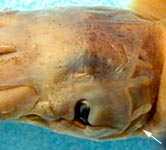
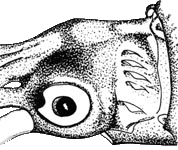
Figure. Dorsolateral views of the head of N. africanae. Left - 5 of the 6 occipital folds visible, 69 mm ML, preserved. The arrow points to the olfactory organ on occipital fold no. 2. Photograph by R. Young. Right - 6 of the 7 occipital folds visible (fold no. 1 not visible), holotype. Drawing modified from Nesis, et al. (1998).
- 6-7 occipital folds on each side in subadults
- Mantle
- Skin smooth.
- Gladius visible dorsally only between fins.
 Click on an image to view larger version & data in a new window
Click on an image to view larger version & data in a new window - Photophores
- Absent.
Comments
Except for the photographs, this description is from Nesis et al. (1998) and Bolstad (2007).
Nomenclature
According to Nesis et al. (1998), this genus erected for squid that had previously been identified as a "Notalian form" of Onychoteuthis banksii, a South Atlantic form of Ancistroteuthis lichtensteinii, or as Onykia (?) verrilli (Pfeffer).
References
Nesis, K. N., M. A. C. Roeleveld and I. V. Nikitina. 1998. A new genus and species of onychoteuthid squid from the Southern Ocean. Ruthenica 8:153-168.
Bolstad, K.S. 2007. Systematics and distribution of the New Zealand onychoteuthid fauna (Cephalopoda: Oegopsida), including a new species, Notonykia nesisi sp. nov. Reviews in Fish Biology and Fisheries 17:305-335.
About This Page
K.S.R. Bolstad

Auckland University of Technology

University of Hawaii, Honolulu, HI, USA

National Museum of Natural History, Washington, D. C. , USA
Correspondence regarding this page should be directed to K.S.R. Bolstad at , Richard E. Young at , and Michael Vecchione at
Page copyright © 2019 K.S.R. Bolstad, , and
All Rights Reserved.
- First online 09 July 2007
- Content changed 29 August 2016
Citing this page:
Bolstad, K.S.R., Richard E. Young, and Michael Vecchione. 2016. Notonykia . Version 29 August 2016 (under construction). http://tolweb.org/Notonykia/108188/2016.08.29 in The Tree of Life Web Project, http://tolweb.org/




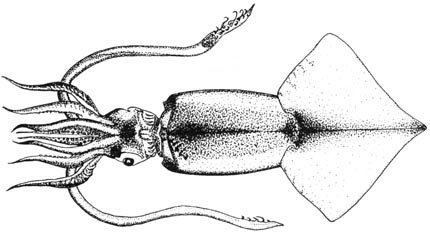
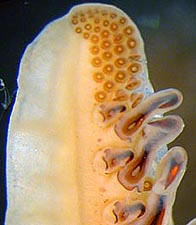
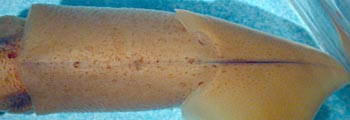


 Go to quick links
Go to quick search
Go to navigation for this section of the ToL site
Go to detailed links for the ToL site
Go to quick links
Go to quick search
Go to navigation for this section of the ToL site
Go to detailed links for the ToL site